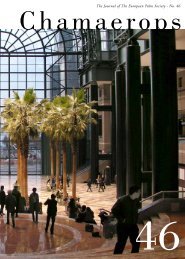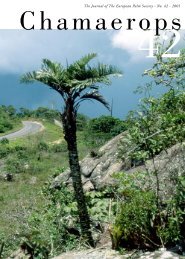Download - The European Palm Society
Download - The European Palm Society
Download - The European Palm Society
Create successful ePaper yourself
Turn your PDF publications into a flip-book with our unique Google optimized e-Paper software.
LettersYour chance to air your views and share your news."<strong>The</strong> New Exotic Garden" - Book Review<strong>The</strong> editorial in Chamaerops 34 discussed theuse of other exotic plants to complement ouroutdoor palm collections. Of particular note wasthe comment "the effect can be jaw-dropping".I wish to draw to the attention of EPSmembers the recent release of an excellent bookentitled "<strong>The</strong> New Exotic Garden" by Will Giles,published by Mitchell Beazley (Hardback, ISBN1-84000-241-7)With many stunning colour photographs itillustrates how to use hardy or near hardy exoticsto introduce colour, texture and form to the cooltemperate garden. <strong>The</strong> author discusses the useof hardy palms, bamboos, phormiums and otherarchitectural evergreens to provide a permanenthardy structure and backbone. Three chaptersthen describe how to create each of the three maintypes of exotic garden :- the colourful tropicallookgarden using contrasting textures and hotreds, oranges and yellows provided by plants likecannas, bananas, gingers, aroids, dahlias andcoleus; the lush jungle-style garden incorporatinghardy ferns, hostas and grasses into the evergreenbackground; and the dry mediterranean stylegarden using succulents, Yuccas and otherdrought resistant plants. Most gardens possess themicroclimates to create at least two of these styles.<strong>The</strong> author then goes on to discuss the techniqueshe uses to grow and over-winter the main groupsof exotics, namely cordylines, succulents, cannas,gingers, tree ferns, aroids, bananas, coleus andbamboo. <strong>The</strong> final chapter is a directory of exoticplants by genus with descriptions of the bestspecies to use, heights, site and soil requirementsand both U.K. and U.S. hardiness ratings.Refreshingly for us palm enthusiasts, the sectionon palms includes not only Trachycarpus andChamaerops but also Brahea, Butia, Jubaea,Nannorrhops and Phoenix.In conclusion, for dedicated palm lovers thisbook offers us the inspiration to turn our spikygreen palm collections into the core of an exoticparadise - well worth the £17.99 asking price.Alan Hindle, Dudley, UKPigmy WaggieBack in 1992 I bought 130 Trachycarpusfortunei seeds and managed to get most of themto germinate. After about18 months I noticedthat 3 had much smaller and stiffer leaves. I keptthese to one side, as I didn't want to sell them orgive them to friends and relatives. <strong>The</strong>y are nowquite definitely Waggies. All 3 grow at the samerate and have approximately the same number ofleaves, but 1 is markedly smaller than the othertwo.<strong>The</strong>y all germinated in spring 1992, so theyare about 8 years old. <strong>The</strong> two larger ones are 38cm tall with 16 cm diameter leaves. <strong>The</strong> smallerone, however, is only 21 cm tall with a maximumleaf diameter of just 9 cm. As I already explainedthe growth rate is the same for all three, only theproportions are different. It will be interesting tosee how thick (or thin) the trunk is, when it growsone. Do you know of any other Pigmy Waggies?DaveThanks Dave, nice picture. Waggies seem tocome in all shapes and sizes. We get them heresometimes with small leaves like yours, but I don'tknow if they retain this stature, or if it grows out asthey get bigger. I suppose the ultimate is no leaf atall, just a collection of petiole stumps! I expect you'replanning to plant them out; it will be interesting topage 20Above: Uxbridge Trachycarpus (see page 23). Below: Pigmy Waggie. >










